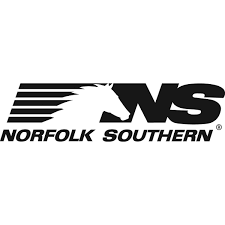
Having fended off the unwanted attention of Canadian Pacific, US railroad operator Norfolk Southern (NS) recently further proved its resilience with a continuing to focus on cost-cutting initiatives.
Investors expect NS to hit about $10bn of revenues this year, with EBIT at $3.1bn, and earnings per share and dividends per share at $5.59 and $2.39, respectively. These targets ought to be achieved: its first-quarter results earlier this year confirmed that it is on the right path, and investors are not expecting any nasty surprises when its next trading update is due on 19 July.
First-quarter revenues came in at $2.4bn, down 6% year-on-year, but lower sales were more than offset by falling operating expenses, which stood at $1.7bn for the quarter, down 13% year-on-year.
NS experienced a 2% reduction in traffic due to lower coal volumes and average revenue per unit declined 3% “as the effects of higher rates were more than offset by a $114m, or 70%, decline in fuel surcharge revenues”.
Core merchandise revenues reached $1.5bn, up 2% year-on-year, with automotive performing particularly well: the unit experienced a significant rise in revenues, up 16% to $254m in the period, but larger top-line drivers – such as chemicals, metals and constructions – fell 3% year-on-year.
Meanwhile, revenues from intermodal activities fell 12% to $522m in the period.
“Growth in international volumes was offset by lower domestic volumes due to the restructuring of the company’s Triple Crown Services subsidiary,” it said.
Finally, coal revenues were under pressure at $349m, down 23% year-on-year – the company blamed a mild winter, low natural gas prices and a weak global export market for such a poor performance.
Notwithstanding those headwinds, net income at group level was $387m, up 25% year-on-year, while EPS came in at $1.29, up 29% year-on-year on a diluted basis and on a total share count that was only 3% lower than in the same period in 2015.
When the latest results were announced on 21 April, president and chief executive James Squires argued that “strong first-quarter results demonstrate the significant progress we are making in line with our strategic plan”.
Following the aborted takeover by Canadian Pacific, things have gone relatively smoothly. NS has looked to streamline operations, reduce expenses and at the same time maintain its customer service levels, and Squires added that “focus on strengthening NS is yielding results, and the company is now on track to achieve productivity savings of about $200m”.
Moreover, the operating ratio – operating expenses as a percentage of revenues – was 70.1%, which not only represented “an improvement of 8% over the prior year” but was also a first-quarter record.
However, given that NS might find it difficult to capture revenue and volume growth opportunities, it continues to focus on a business plan that targets annual productivity savings of more than $650m and an operating ratio below 65% by 2020.
Source: Transport Intelligence, June 21, 2016
Author: Alessandro Pasetti